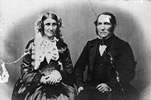The mundane, taken-for-granted business of household management underpins the rest of life. Running a household involves housework, gardening, home repairs, maintenance, renovation, budgeting, buying food, organising tradespeople, paying rates and insurance. Paid work and household tasks impinge on care of children, the elderly or the unwell.
Household management has been shaped by technology, ethnicity and class. The people living in a home – their age, relationship and number – also determine many routines.
Technology
Although many tasks have not changed, the way they are carried out has altered. Change has usually been driven by technological developments. From the 19th to the mid-20th century heavy work became lighter. This occurred first away from home – farms and factories were the first to use new sources of power and machinery – but by the 1960s running a household was far less physically demanding than it had previously been.
Class
A household’s wealth affected how it was run. The poor and lower middle class did most things themselves, while the middle class and wealthy were able to delegate. Servants were hard to find, though, and by the later 19th and early 20th centuries, only about 10% of households had a servant or servants.
Reading to the family
Family reading sessions took place in many 19th-century households. The Bible, a daily newspaper, a novel or a serialised story in a magazine provided entertainment, education or religious instruction. If an adult in the household couldn’t read, someone else would read letters to them and write out their reply. The household’s reader might be an adult, but could also be a child.
Who and how many
In Pākehā households the presence of young children, the elderly or the unwell usually meant a more home-centred life, and added to a household’s tasks. A very large family or the presence of unmarried adult family members meant more work, but also that tasks were shared around more. Until the 1950s many Māori lived in extended-family households, with the presence of young, old, married and unmarried adults taken for granted. The extra care needed by young and old along with the extra help provided by many adults were probably also taken for granted.
Gender roles
From early settlement to the later 20th century, Pākehā men and boys were responsible for outdoor tasks, while women and girls cared for household members and performed indoor tasks. This division of work was not rigid. A different tradition, personal preference or necessity might dictate other patterns of behaviour.
Learning to keep house
Pākehā spent a great deal of energy persuading Māori to follow European household routines. Girls in particular were taught cooking, sewing and household hygiene. At first the training was seen as a way of turning Māori into brown Britons. Later, when Māori population decline became obvious, many Pākehā and some Māori believed these routines would improve Māori health.
Small farms, particularly while being established, often required the labour of all those available. In some rural households, women’s work included both the house and the farmyard with its hens, home garden and house cow. In town or country, a father might feed children or wipe a snotty nose, particularly in a large family with young children. Older children helped in many households, particularly if the family was large or parents were unavailable. Historical evidence of home repairs and maintenance suggests that this work (except painting) was consistently done by men.
Loss of a husband or wife radically altered the experience of running a household, as the remaining partner and older children struggled to do the extra work or find someone else to undertake it.
Renting
In the early 20th century nearly half of all households were renting their home. Home ownership rose from the 1920s, reaching approximately 73% in the 1980s, and began to fall again in the 1990s. Apart from repair and maintenance work, which those in a rented home were far less likely to do, the work of household management remained the same.
This changed once flatting – groups of unrelated people living together – became common in the 1960s. Some flats had a shared food budget and shopping, cooked as a group and ate together. In others the occupants did little more than share facilities and power costs.
